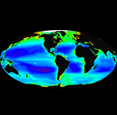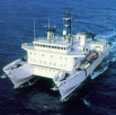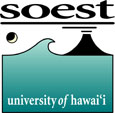Housing
Students shared dormitory rooms on the University
of Hawaii campus. These rooms are not air conditioned and
could be warm in the evening. Linens were provided by the
campus housing; however, students needed to bring a towel. A map of the University of Hawaii campus was provided so that students could
become familiar with the layout of the campus. Students were housed on the East-West Center cottages and lectures and laboratories occured in the Marine Science Building and the Pacific Ocean Science and Technology Building.
Meals were provided three times a day (breakfast, lunch,
and dinner) through the University of Hawaii campus meal plan.
These meals were available at a central cafeteria. (For
more information on the University of Hawaii at Moana campus,
please click here.)
While at sea, students shared cabins. All linen were
provided on the research vessel. In addition, three meals
were served at sea. Although the R/V Kilo Moana is renowned
for its stability at sea, students prone to seasickness, or
those unsure if they get seasick, were advised to bring appropriate
medication.
Travel Arrangements
For travel arrangements, students were advised to contact Lynnell Yee, European
World Travel, at (877) 925-558, or by email at lynnell@europeanworldtravel.com
Hawaii Climate
In July, daytime temperatures in Hawaii can be hot
(average temperature in July 29.4°C), but most building are
air conditioned. Students were advised to bring clothing that suits
the climate; shorts could be worn during lectures and laboratories.
We suggested bringing a long sleeved sweatshirt to be worn in
the air conditioned classrooms. Closed-toed shoes were required
during laboratory research. In addition, while at sea, students
were advised to bring closed toed shoes that can get wet.
|






